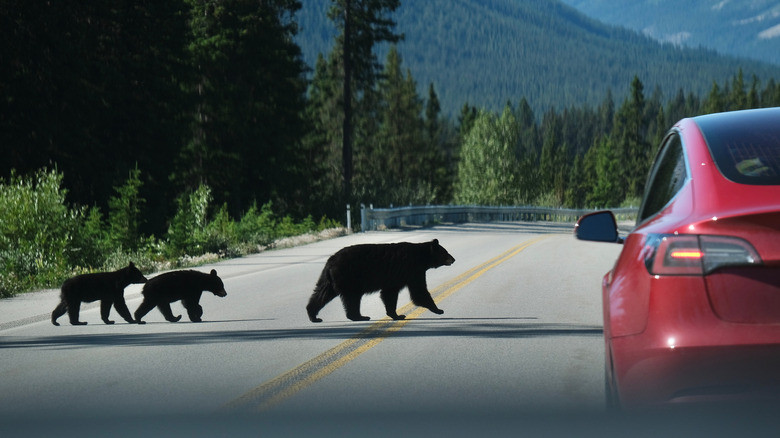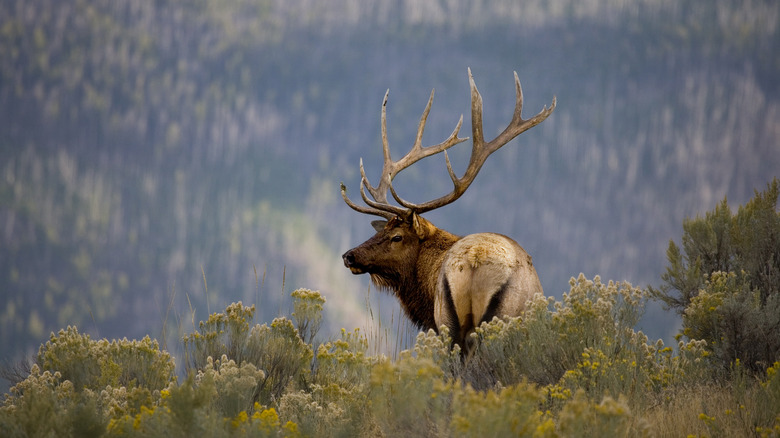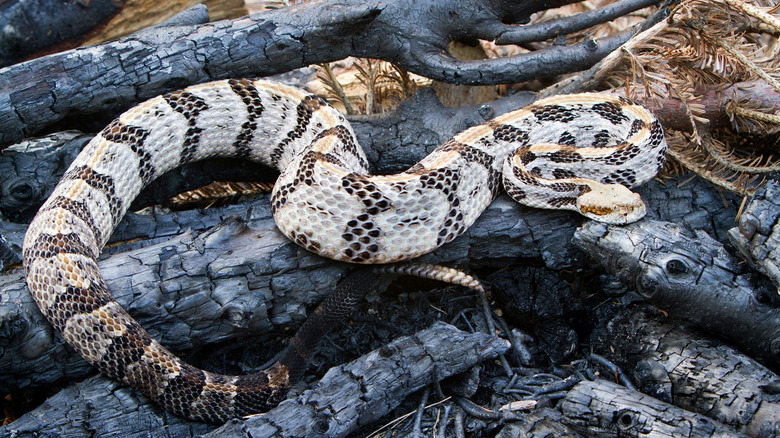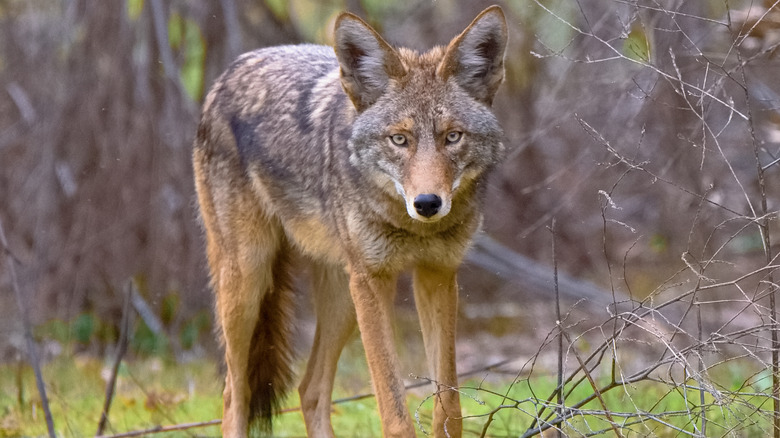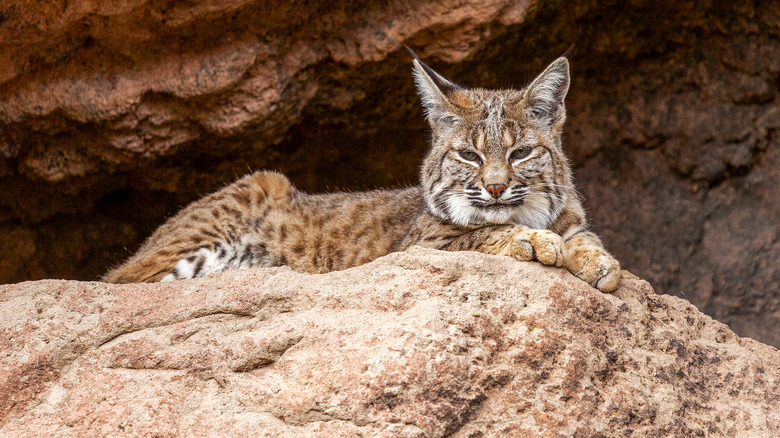5 Creatures To Beware Of When Adventuring In The Smoky Mountains
The Great Smoky Mountains are America's most-visited national park — and for good reason. These enchanting forest-covered mountains make you feel like you are lost in another world as you explore winding trails and waterfalls. In fact, visiting this national park is almost like going back in time because around 25% of the Smokies are covered in old-growth forests containing trees that date back centuries. It's partly for this reason that we think the Smoky Mountains deserve to be on everyone's national park bucket list.
Besides the forest itself, another draw to this national park is what lives beneath the trees. According to the National Park Service, there are more than 200 types of birds and about 65 varieties of mammals, not to mention 80 species of amphibians and reptiles and 67 fish native to the area. However, while it may be exciting to see and experience the wildlife of the Smokies, it is also important to respect any animal you encounter and keep your distance because some of them are more dangerous than most visitors realize. Not giving wildlife enough respect is one of the biggest mistakes people make when visiting national parks because it not only creates situations that are dangerous for the animals and the ecosystem but also for the visitors themselves. So, if you plan to visit the Smoky Mountains, here are some animals you should beware of.
Black bears are nicer than grizzlies but still dangerous
Compared to all of the other bear species in North America, black bears seem to have a better temperament. In fact, startled black bears are more likely to run away than attack, unlike grizzlies and brown bears which quickly turn aggressive when surprised. However, despite being a "nicer" bear, black bears are still bears and are dangerous and unpredictable wild animals armed with razor-sharp teeth and claws. Because of this, it is illegal to purposely get within 150 feet of a black bear in the Great Smoky Mountains. Furthermore, dogs are not allowed inside the park because they can aggravate wildlife, including bears — which experts believe are more easily triggered to attack if a dog is present.
However, while most of us would never purposely get close to a wild bear, what should you do if you encounter one accidentally? According to the National Park Service, if you see a black bear in the wild and it continues on its way after noticing you, you should be okay and can continue. However, if the bear stops what it is doing and watches you or begins to approach, you should immediately back away and leave the area. Don't turn your back on or run from a bear. If a black bear attacks, always fight back and try to hit the bear in the snout or face.
Elk like their space
Elk – although originally native to the Smoky Mountains — were overhunted to the point that there were no more of these beautiful creatures in the Smokies by the mid-1800s. With conservation efforts over the last 100 years, elk have become more widespread across North America and were reintroduced to the Smokies in 2001.
Although these large animals look elegant and majestic from afar, the truth is that their impressive strength, sharp antlers, and large bodies (bull elk can weigh up to 700 pounds) make them quite dangerous. They are also unpredictable and are likely to lash out if a person gets too close. The National Park Service recommends staying at least 100 feet away from all elk. Both male and female elk can be aggressive throughout the year, but females tend to be more prone to attacks when they have calves and males are more aggressive during the fall mating season.
Many people in national parks across the U.S. try to get close to wild elk for photographs. However, even if you escape a purposeful elk encounter unharmed, the animal may not get the same outcome. If an elk is found by park officials to have lost its fear of humans, it could be euthanized as it would likely become a danger to visitors in the future.
Venomous snakes are hard to see
While there are many different types of snakes in the Smokies, there are only two venomous species that you need to look out for and these include timber rattlesnakes (sometimes called timber rattlers) and northern copperheads.
Of the two, the timber rattler is the most venomous but least aggressive. Although timber rattlers can kill a person with one bite, they often prefer to give their noisy warning and retreat over attacking. If you encounter a rattlesnake while hiking, you should back away and go around it. You may also be able to convince the snake to retreat by stomping on the ground (while standing a good distance away). If you are bitten by a timber rattler it is an emergency and you should get to the nearest hospital as quickly as possible.
Northern copperheads are also venomous but luckily the bite of this snake doesn't contain enough poison to kill you. However, copperheads give no warning before striking and their bites are quite painful. Although they tend to try and avoid people, they will bite when threatened. In fact, the snakes are responsible for the most bites of any venomous snake in the United States. According to National Geographic, the pit vipers are responsible for 7,000 to 8,000 human bites annually.
Coyotes are opportunists
Because red wolves were hunted to extinction in the Smoky Mountains by the 1980s, coyotes are now the park's largest and most dangerous canine. Even so, coyote attacks on humans are very rare as these elusive scavengers prefer to hunt at night and avoid humans. While coyotes rarely attack adults, they may be more willing to attack children or pets. Because of this, however unlikely, it's a good idea to always keep your children close and never let them wander the trails of the Smokies alone.
What should you do if you see a coyote while in the Smokies? First, try and keep your distance from the animal and leave it alone. Most likely the coyote will continue on its way and give you a wide birth. However, coyotes that have begun to associate humans with food may try to approach and could become aggressive. If a coyote approaches you, start throwing rocks or sticks at it and shout or wave your arms to scare it off.
Bobcats are shy but have a mean bite
Out of all the Smoky Mountain animals on this list, bobcats are the ones you are probably least likely to encounter or be attacked by. This is because bobcats are both nocturnal and extremely shy — so much so that most people consider seeing one as a lucky moment that should be cherished.
A healthy bobcat will likely never attack a human unless cornered. However, the problem with bobcats is that they look pretty similar to house cats and, because of this, some people assume they are sweet and cuddly (they're not) and try to approach them. A bobcat that is approached by a human will likely run away. However, a mother bobcat with kittens may stand her ground and fight back.
If a bobcat approaches you, that is a sign that something is not right. In this situation, it is probable that the cat is preparing to attack you or is rabid. Rabid bobcats have been known to chase down and attack both humans and pets.

